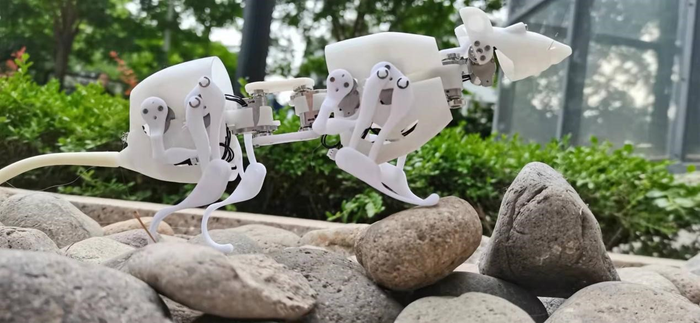Legged robots have a lot of potential for real-world applications, but getting them to work in narrow spaces is still a challenge.
 The robotic rats were designed with high environmental adaptability based on a systematic analysis of the morphology and motion properties of atcual rats. Image Credit: Photo by Qing Shi from Beijing Institute of Technology, China.
The robotic rats were designed with high environmental adaptability based on a systematic analysis of the morphology and motion properties of atcual rats. Image Credit: Photo by Qing Shi from Beijing Institute of Technology, China.
Large quadruped robots, such as BigDog and ANYmal, have excellent adaptability and load capacity but are unable to enter narrow spaces, whereas micro quadruped robots, such as sub-2g robots, were able to enter narrow spaces but were unable to complete tasks due to its low absolute payload capacity.
Designing a tiny biomimetic robot capable of executing various actions and carrying payloads is one method for improving its environmental adaptability. Due to their unrivaled agility and adaptability, rats (Rattus norvegicus) have drawn a lot of interest in this situation. Many attempts have been made to replicate the morphology or movement of rats.
A team led by Prof. Qing Shi from the Beijing Institute of Technology in China has developed the SQuRo (small-sized quadruped robotic rat), which was published in the journal IEEE Transactions on Robotics on April 7th, 2022.
Prof. Qing Shi of the Beijing Institute of Technology in China has been working in this area for more than 10 years, starting as a Ph.D. student at Waseda University. Prof. Shi’s team has created robots that can mimic the movement and behavior of biological systems by spending a lot of time mimicking specific traits and functions.
Scientists created a wheeled robotic rat that can perform a variety of rodent-like activities using bioinspired design. Researchers chose to replace the wheels with legs to improve movement agility even further. Experiments show that the legged robot SQuRo can simulate the movements of real rats in small places, according to the findings of this study.
Rats’ extended slim form and unrivaled agility allow them to adapt to narrow spaces. As a result, researchers make extensive use of the morphology and motion features of rats moving in caves to mimic movement agility.
Scientists started by extracting the rats’ key movement joints (KMJs) and completing the DOF configuration (degree of freedom). Researchers created two DOFs in each limb to simulate limb movement, two DOFs in the waist, and two DOFs in the head to replicate flexible spine movement. SQuRo can flex its body and turn swiftly thanks to its long and flexible spine.
Furthermore, rats have a distinct advantage in their agile movement, which mimics a variety of normal actions. A robotic rat, in addition to copying the morphology of rats, also has the motion control characteristics of rats. To accomplish multimodal motion similar to that of rats, researchers proposed a hierarchical open-loop controller.
There are three levels to the control framework:
- A multi-motion planner with four fundamental motion modes and a direct link between the controlling variable and ground reaction forces (GRFs)
- Parameter management with stability and actuation restrictions in consideration
- Joint trajectory generation
The control structure allows for quick transitions and agile motions.
SQuRo can execute numerous actions, including crouching-to-standing, crawling, walking and turning, and can recover from a fall by regulating its limbs and cervical components to suitably shift its center of mass (CoM), thanks to its biomimetic flexible construction and multimodal motion control.
Furthermore, SQuRo demonstrated its potential applicability to inspection jobs within narrow spaces by passing through an irregular narrow tunnel (inner width of 90 mm), crossing a 30 mm high barrier, and maintaining steady locomotion on a 15° incline slope in field testing.
In comparison to similar-scale state-of-the-art quadruped robots, the newly created SQuRo has a more elongated, leaner body and less weight. When compared to other robots, the lowest turning radius of 0.48 body length (BL) is significantly less.
Moreover, when compared to small-sized quadruped robots, SQuRo can maintain stable locomotion even when carrying a payload equivalent to 91% of its weight, demonstrating its better payload-carrying capabilities. These skills enable SQuRo to navigate through narrow spaces and rough terrains while performing activities like detection and transportation in applicable settings.
Journal Reference:
Shi, Q., et al. (2022) Development of a Small-Sized Quadruped Robotic Rat Capable of Multimodal Motions. IEEE Transactions on Robotics. doi.org/10.1109/TRO.2022.3159188.